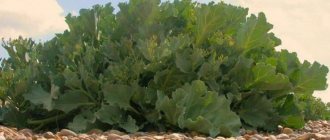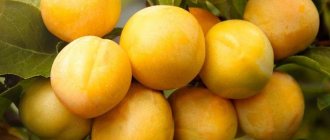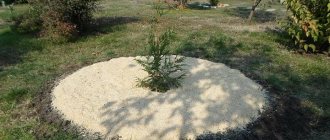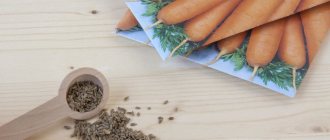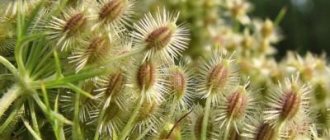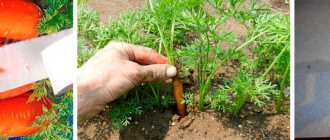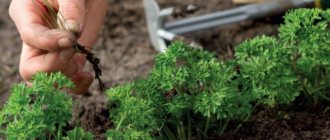The carrot fly is a red-colored insect 0.5 cm in size. The damage it causes cannot be measured.
From late May to early July, the fly lays eggs in the neck of the carrot root. After about a week, they hatch into larvae - the main pests.
After 3 weeks, they emerge from the carrots into the soil, pupate and remain there to overwinter.
If the larvae do not have time to do this before harvesting, they remain in the carrots and continue to feed on it.
Allium is the main protector of carrots from carrot flies
Each plant species has preferences when it comes to their neighbors. Some plants compete with each other for resources and are detrimental to the health of their neighbors, and some plants combine well and are beneficial when planted next to each other. Strongly scented alliums such as garlic and onions make excellent companion plants for carrots, and alliums will help repel carrot flies as well as other pests.
Try to place separate small carrot beds at a distance
Many gardeners have found that spreading their carrot plots around the garden helps ensure that at least some of the garden bed groups remain unharmed. Instead of growing one large carrot patch and having all your carrot harvests together in one place, try keeping several carrot patches separate from each other. Of course, caring for carrots takes a lot of time, but by creating separate beds you will increase the likelihood of growing a certain portion of healthy carrots!
Reasons for appearance
Flies appear in carrot beds looking for food. They begin to fly in the spring. The first clutches of eggs are made at the base of young green carrot shoots. The larvae go into the roots of the vegetable. They pupate in the soil. In June, the first generation of sexually mature flies appears. And after 2-3 weeks, the next one is ready for fertilization.
The autumn brood of larvae pupate in root crops . Such contaminated carrots, which were planned to be stored all winter, quickly rot and disappear. The female gives more offspring if the summer is warm and watering is plentiful.
Change the places (rotate) where your plants are planted to effectively combat carrot flies
Avoid planting the same plants in the same areas of your garden crops each planting season. Once the carrot root fly larvae are full, they overwinter in the soil surrounding the plants. If you plant carrots in the same location as last season, the flies will wake up, find their familiar surroundings, and lay eggs right in the middle of your carrots again. Rotating your crops each growing season is a simple solution to avoid this problem, and it is also beneficial to ensure that your fertile gardening soil has more variety in the plants' needs from season to season.
Prevention of arthropod damage
The best option for planting carrots is after garlic, radishes, onions, and tomatoes.
- Manure should not be placed in the ground. It is allowed to mulch the beds with peat.
- After thinning the beds, the waste must be destroyed.
- Before sowing, water the beds well with a solution of birch tar (1 tablespoon per bucket of water). You can repeat the procedure if necessary.
- You need to get rid of the grass of the Umbrella family, as winged ones love it. This group includes clover and dandelion.
- It is better to sow carrots in early spring, when the weather conditions are suitable.
- Choose dry, easily ventilated soil for sowing vegetables.
Cover the carrots with a fine mesh
If possible, cover your vegetable beds with fine mesh to prevent flying insects from laying eggs in the soil surrounding your vegetables. Fleece is also a good cover for vegetable beds. Lay the fleece softly over the tops of your vegetable plants and secure it tightly around the edges to keep flies and other pests out. Although this method is not always possible, most gardens can be covered with relative ease at low cost, and this preventive method can save you a lot of work and stress in the long run, as well as saving you the money spent on buying fertilizer each year.
Means of struggle
Chemical and biological drugs
Arrivo
Enteric-contact insecticide with long-term protection. Dosage of the drug: 2 ml per 10 liters of water. After adding the emulsion to the water, the solution is thoroughly stirred.
Decis Lux
A universal drug that destroys insects at different stages of development with a high concentration of the active substance. Penetrates the pest's body after it eats the treated parts of the plant and causes its death. Doesn't wash off in the rain. To destroy carrot flies, prepare a solution at the rate of 5 ml of emulsion and 20 liters of water.
Aktara
Systemic drug based on thiamethoxam. This is a highly toxic drug, it is used while observing dosage and safety precautions.
1.4 g of insecticide is dissolved in 10 liters of water and sprayed on the plants. The death of the pest occurs on the first day after eating the treated aerial parts.
Fly eater
Granular product based on diazinon. Destroys adult insects and their larvae. Dry granules are placed between rows at the rate of 50 g per 1 square meter. m. Use only once during the season.
Prestige
The beds are watered with a solution of this drug after the first shoots appear, and the seeds are soaked in it before sowing. The consumption of the preparation for irrigation is 2 ml per 10 liters of water, the seeds are pickled for 6–8 hours in a solution of 1 ml of insecticide and 1 liter of water.
Phytocide
Biological product based on beneficial bacteria. Used to treat seeds before planting. The seeds are soaked for 1.5–2 hours in a solution prepared from 5–10 ml of the product and 0.5 liters of water. This product will protect future plants from pest attacks and fungal diseases.
Fitoverm
An effective natural preparation based on soil microorganisms. To treat carrot flour, prepare a solution of 2 ml and 1 liter of water.
An excellent result is achieved by the combined use of this drug and the bioinsecticide “Dachnik” (a natural product based on fir oil). Add 1 ml of “Dachnik” product to the prepared Fitoverma solution.
Traditional methods
During the summer period, the pest actively uses herbal medicines. Insects cannot tolerate many strong and pungent odors.
- 4 kg of crushed tomato stems and leaves are poured into 10 liters of water. Boil for 30 minutes, then leave for 3-4 hours. The infusion is filtered, liquid soap is added and the plants are sprayed.
- Finely chop 200–300 g of onion or garlic heads and pour 2 liters of boiling water. The concentrate is infused for a day and filtered. To treat plants, add water to the infusion to a volume of 10 liters and add liquid soap.
- The first shoots are sprayed with a vinegar solution; 2 tbsp are diluted in 8 liters of water. l vinegar essence.
- Marigolds, yarrow, and wormwood have good repellent properties. The bucket is filled with herbs and poured boiling water. Leave until the liquid cools and filter. The plantings are sprayed with a solution with the addition of liquid soap, and the slurry is spread between the beds.
Plants are treated with phytosolutions 2-3 times in the morning or evening with an interval of 5-7 days. The effect of the treatments lasts up to 5 days. These procedures are carried out until there is a massive pest invasion and only the first signs of infection are noticed.
- In the spring, the beds are watered with a solution of ammonia. 1–2 tbsp. spoons are poured into 10 liters of water. The pest will be repelled by the sharp smell of the drug, and for the plant such watering will be a nitrogen fertilizer.
- Naphthalene tablets give good results; they are laid out on the beds.
- During the egg-laying period, the row spacing is dusted with tobacco or mustard powder 2–3 times with an interval of 7 days at the rate of 1 tbsp. l per 1 sq. m.
- During the active summer of the carrot fly, baits are placed between the rows. Fermented bread kvass is poured into plastic bottles with the neck cut off. Insects attracted by the smell fall into the trap bottle.
- The carrot fly is a favorite delicacy of toads and frogs. They catch them with pleasure and eat to their fill. To attract them to the site, a home is set up for them in cool corners - a small pile of old firewood or boards.
Nematodes (roundworms) and other beneficial insects to control carrot flies
Use some organic pest control (such as sticky traps) or biological control (such as using nematodes) to control carrot flies. These nematode treatments are easy to use and can help control carrot flies. Simply mix nematodes with water and water the plants with the mixture during regular watering. The nematodes will disperse into the soil and immediately go to war against any threats to the vegetables living there, killing every pest in sight and protecting your plants. SuperNemos is a well known and widely used nematode brand with good customer reviews.
Description
The carrot fly is widespread in Russia (its European part), Western Europe, Siberia, North America and New Zealand.
The emergence of pests begins in May, when the apple and bird cherry trees bloom. They love moist places in the shade.
The carrot fly (from the Latin Chamaepsila rosae) is an insect of the Psilidae family, 4–5 mm in size, black with a green tint.
The head is round in shape, red-yellow in color, covered with bristles. On the crown, around the usual eyes, a dark spot is visible. A lush mustache is located under the forehead. The tentacles and legs are light yellow. The shiny green wings with yellow veins are larger than the oval abdomen.
Types of flies
There are two types of insects: female and male.
They differ in the structure of their genital organs. The first has an unsclerotized, retractable ovipositor. The second has normally straight hind femora and also has notopleural setae on the chest. 2-3. What does the pest and its larvae look like?
Reproduction and egg laying occur over 4-6 weeks. In the evening, females place them near or on the very root of the carrot. The approximate number of eggs is 110 pieces.
The embryo can develop within two and a half weeks. Its color is white, length 0.6 mm, oval shape. At the back of the embryo a stalk-like narrowing was found. The pale yellow larva reaches 6–7 mm. The anterior end of the body is pointed, and the posterior end is rounded.
Use delayed planting of carrots to control carrot flies
Carrots planted later than usual, starting around June, usually miss the first round of pests. Don't just plant your carrots late and assume everything will be fine—this early bird strategy simply gets them off to a good start. You should still use other preventative methods to keep carrot flies at bay, as the second round of eggs will hatch between July and September.
It's all about timing and persistence. You can win the war even if you lose a battle or two. Apart from pest control, carrots do not require much care. Simply keep the area in which you grow carrots weed-free, avoid over-watering, and you'll have a wonderful supply of these tasty root vegetables in no time.
What does the pest eat?
The larvae, which develop from eggs, immediately burrow into tender plants . Most often they rush to the tips of their roots . They gnaw passages in them, acquiring an unsightly shade of rust. Root vegetables look unpresentable and become tasteless .
Which plants are susceptible to damage? This insect attacks not only carrots . Parsnips and celery , as well as parsley can suffer from it .
The fly especially loves damp and shaded areas . It is in such places that it causes the most severe damage to the crop .
Important: if you plant spring garlic or onions together with carrots, this will help eliminate the smell of carrots, which attracts pests, and save the harvest.

